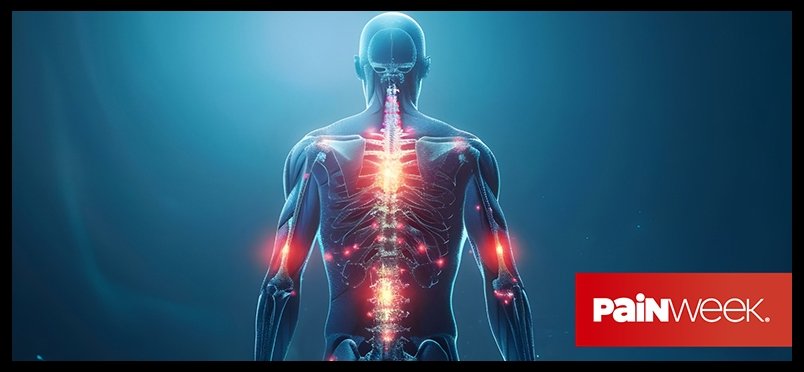| chemotherapy induced peripheral neuropathy (CIPN)
The Ultimate Blueprint for Mastering Peripheral Neuropathy

As healthcare providers, we often encounter challenges in managing diabetic peripheral neuropathy (DPN) and chemotherapy-induced peripheral neuropathy (CIPN). At PAINWeek, we believe that education is the best analgesic. Today, we highlight key considerations and recent developments in the treatment of DPN and CIPN to better equip you to manage these conditions effectively.
Understanding the Impact of DPN and CIPN
Treating diabetic peripheral neuropathy (DPN) and chemotherapy-induced peripheral neuropathy (CIPN) requires both pharmacological and non-drug therapies. Pharmacological options primarily target pain relief, which affects 25% to 35% of patients with DPN. However, many patients with DPN receive doses lower than recommended, leading to inadequate symptom management and discontinuation of treatment. Correctly identifying the underlying cause of peripheral neuropathy is essential for selecting the appropriate treatment.
Many clinicians may not be fully aware of the current treatment options for DPN and CIPN, including their safety, effectiveness, and how to tailor them to individual patients. Patients with DPN and CIPN often experience a diminished quality of life, frequently struggling with falls, injuries, and infections (American Cancer Society, 2019). Additionally, over 50% of amputations in the United States are associated with DPN. Neuropathic pain is extremely complex to treat, necessitating a comprehensive and informed approach.
Delving into the Etiology of Neuropathic Pain
-
CIPN: Pharmacological effects of specific chemotherapy agents, including:
-
Platinum drugs (cisplatin, carboplatin, oxaliplatin)
-
Taxanes (paclitaxel, docetaxel, cabazitaxel)
-
Plant alkaloids (vinblastine, vincristine, vinorelbine, etoposide)
-
Immunomodulating drugs (thalidomide, lenalidomide, pomalidomide)
-
Proteasome inhibitors (bortezomib, carfilzomib, ixazomib)
-
Revolutionizing Treatment: The Current Landscape of DPN and CIPN Therapies
- Pharmacological interventions:
- OTC: NSAIDs, acetaminophen, topical capsaicin, lidocaine
- Prescription:
- Oral: antidepressants, antiseizure drugs, opioids
- Topical: prescription capsaicin patches, clonidine gel, isosorbide dinitrate spray
- FDA-approved therapies for painful diabetic neuropathy (PDN):
- Duloxetine, pregabalin, tapentadol ER, capsaicin (foot PDN only)
- Spinal cord stimulation system
- Other recommended treatments (by various regulatory bodies):
- Gabapentin, amitriptyline, dextromethorphan, tramadol, venlafaxine, sodium valproate, 5% lidocaine patch
- Non-pharmacological approaches:
- Interventional: surgery, implant devices, electrical stimulation
- Complementary: acupuncture, physical therapy, relaxation therapy
- Orthopedic aids: hand/foot braces, specialized footwear
- Lifestyle modifications: diet, exercise, nutritional supplements
Navigating Clinical Challenges in Neuropathy Management
-
Suboptimal prescribing patterns: Many patients receive less than the recommended dose of medications, leading to poor symptom management and treatment discontinuation.
-
Accurate diagnosis: Correctly identifying the underlying cause of peripheral neuropathy is crucial for appropriate treatment selection.
-
Medication burden: Many patients, especially those with diabetes, are already managing multiple medications and may be reluctant to add more.
-
Treatment resistance: A significant number of patients continue to struggle with chronic pain despite being on traditional therapies.
Recent Breakthroughs in Neuropathy Treatment
The American Association of Clinical Endocrinology (AACE) has released a comprehensive algorithm to guide clinical decision-making for type 2 diabetes management, including associated complications like DPN. This resource covers 11 distinct areas, from glycemic control to cardiovascular risk reduction. Click here to learn more about the AACE guidelines.
Clinical Insights for Personalized Neuropathy Care
-
Individualized treatment: Consider each patient's comorbidities, potential adverse effects, drug interactions, and costs when selecting treatment options.
-
Comprehensive approach: Integrate both pharmacological and non-pharmacological interventions for optimal outcomes.
-
Patient education: Ensure patients understand the importance of adherence and the potential benefits of lifestyle modifications.
-
Regular assessment: Continuously evaluate treatment efficacy and adjust as needed.
-
Stay informed: Keep up-to-date with emerging therapies and guidelines for neuropathy management.
By addressing these clinical gaps and leveraging the full spectrum of available treatments, we can work towards improving outcomes for patients with DPN and CIPN. Remember, a personalized, multifaceted approach is often key to successful management of these challenging conditions.
Elevating Your Expertise in Neuropathy Management
To deepen your understanding of this topic, consider attending PAINWeek 2024, scheduled for September 3-6 in Las Vegas, NV. Featured sessions:
-
SIS-14 - Walking on Spikes or Clouds? Diabetic Peripheral Neuropathic Pain Treatment Options presented by Ramon L. Cuevas-Trisan, MD
-
Hitting a Nerve! Management of Chemotherapy-Induced Neuropathic Pain presented by Laura Meyer-Junco, PharmD, BCPS, CPE, FASCP
-
CPM-06 - Awkward Conversations: Managing Patients with Chronic Pain presented by Paul G. Mathew, MD, DNBPAS, FAAN, FAHS
-
INTG-05 - Nourishing Nerves: Navigating Nutrition Driven Pain Management presented by Celeste Nadal, MD; Hannah Thorfinnson, PharmD; Olivia Schmidt, RDN, LDN
To learn more and register for PAINWeek 2024, click here.
Other Categories:
Did you enjoy this article?
Subscribe to the PAINWeek Newsletter
and get our latest articles and more direct to your inbox
